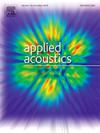Multi-gradient acoustic black hole metamaterial for near-perfect sound Attenuation: Theory, simulation and experiments
IF 3.4
2区 物理与天体物理
Q1 ACOUSTICS
引用次数: 0
Abstract
A multi-gradient acoustic black hole metamaterial module (MABHM) based on a genetic algorithm-neural network (NN-GA) is optimally designed for near-perfect sound attenuation of sub-wavelength metamaterial structures. Simulation results show that the absorption coefficient of the MABHM is up to more than 0.9 in the range of 300 Hz-20 kHz, and the MABHM has a good absorption effect for sound waves with different incident angles. The complex acoustic impedance of the MABHM has a phase loop approximating near the (1,0) coordinates. It is proved that the impedance matching effect is the key to realizing near-perfect sound absorption. The sound transmission loss curves of MABHM with different perforation ratios are the same, and the sound insulation at frequencies above 200 Hz reaches more than 35.0 dB. The experimental results of sound absorption coefficient and sound transmission loss are consistent with the simulation results. MABHM has the advantages of low-frequency broadband sound absorption and insulation, which can be used to realize nearly perfect noise reduction.
求助全文
约1分钟内获得全文
求助全文
来源期刊

Applied Acoustics
物理-声学
CiteScore
7.40
自引率
11.80%
发文量
618
审稿时长
7.5 months
期刊介绍:
Since its launch in 1968, Applied Acoustics has been publishing high quality research papers providing state-of-the-art coverage of research findings for engineers and scientists involved in applications of acoustics in the widest sense.
Applied Acoustics looks not only at recent developments in the understanding of acoustics but also at ways of exploiting that understanding. The Journal aims to encourage the exchange of practical experience through publication and in so doing creates a fund of technological information that can be used for solving related problems. The presentation of information in graphical or tabular form is especially encouraged. If a report of a mathematical development is a necessary part of a paper it is important to ensure that it is there only as an integral part of a practical solution to a problem and is supported by data. Applied Acoustics encourages the exchange of practical experience in the following ways: • Complete Papers • Short Technical Notes • Review Articles; and thereby provides a wealth of technological information that can be used to solve related problems.
Manuscripts that address all fields of applications of acoustics ranging from medicine and NDT to the environment and buildings are welcome.
 求助内容:
求助内容: 应助结果提醒方式:
应助结果提醒方式:


